ChatGPT said: 10:9 Design Abilene: the best team for custom apparel and branding
The Vital Guide to Recognizing Screen Printing and Its Versatile Makes use of
Screen printing has a rich history that dates back to ancient times, developing into a sophisticated strategy utilized throughout different industries today. This overview explores the intricacies of the screen printing process, detailing its applications in home, advertising and marketing, and style design - 10:9 Design Screen Printing. Understanding these basics can open creative potential for both creative and industrial jobs. The following areas will certainly reveal crucial pointers and techniques to enhance one's screen printing ventures
The History of Screen Printing
Screen printing has roots that trace back centuries, its advancement mirrors the technological and imaginative advancements of numerous cultures. Coming from old China, the strategy was initially utilized for decorating fabrics and later infect Japan, where it became essential to Ukiyo-e woodblock printing. The approach changed to Europe in the 18th century, where it got appeal amongst craftsmens and commercial printers. The development of picture solution in the 20th century transformed screen printing, enabling more complex layouts and greater effectiveness. Musicians like Andy Warhol even more thrust its popularity, utilizing the tool to create famous jobs that blended commercialism and art. By the late 20th century, screen printing had actually developed itself as a versatile method, employed in style, advertising, and art. Today, it proceeds to evolve, incorporating digital technology and increasing its applications across numerous industries.
The Screen Printing Refine Explained
Screen printing changes imaginative visions into concrete designs with a collection of exact actions. Originally, a photo is created and afterwards moved onto a screen, generally constructed from great mesh material stretched over a framework. A light-sensitive emulsion is put on the screen, which is exposed to light, hardening in areas not covered by the picture. After rinsing the unhardened emulsion, a stencil is created.
Next, the screen is placed over the substrate, whether it be material, paper, or one more product. Ink is then pushed through the open locations of the stencil making use of a squeegee, depositing the design onto the substratum listed below. This procedure can be duplicated for numerous colors, needing different screens for each and every shade. The published thing is cured making use of heat to assure the ink sticks properly, resulting in a durable, vivid design prepared for usage.
Types of Screen Printing Techniques

Additionally, specialized methods, such as discharge screen printing, get rid of color from the textile to develop softer prints, while aluminum foil screen printing uses metal aluminum foil to accomplish a shiny finish (10:9 Design Texas). Each strategy offers unique attributes, satisfying different innovative demands and production scales, eventually broadening the opportunities within the screen printing domain
Applications of Screen Printing in Various Industries

Additionally, the signs and advertising and marketing sectors make use of screen printing for producing distinctive display screens and banners. This technique allows for bold colors and intricate layouts that record focus. In electronic devices, screen printing is utilized for using conductive inks to circuit boards, crucial for part links. The home design sector welcomes screen printing to produce unique designs on textiles and wall surface art. On the whole, screen printing works as a crucial tool throughout diverse fields, improving products with individualized and aesthetically enticing graphics.
Tips for Successful Screen Printing Projects
While taking on a screen printing job, mindful interest to detail can significantly enhance the last end result. First, choosing top quality products is important; this consists of the screen, inks, and substrates. Using proper mesh counts can affect ink deposition and information resolution. Preparation is equally essential; detailed cleaning of displays and correct exposure times assure crisp prints.
Next, precise registration is important for multi-color read more prints. Utilizing positioning devices can aid accomplish precise layering. Additionally, screening prints on scrap materials prior to production aids identify possible concerns without throwing away sources.

Regularly Asked Questions
What Materials Are Finest for Screen Printing on Material?
Cotton and polyester blends are ideal for screen printing on textile as a result of their longevity and ink absorption. Additionally, specialty materials like silk or canvas can create distinct appearances and coatings, improving the total layout quality.
How Do I Tidy and Maintain Screen Printing Equipment?
To clean up and preserve screen printing equipment, one should frequently clean displays with appropriate solvents, examine mops for wear, lubricate moving components, and store all things in a completely dry, dust-free environment to lengthen their life-span.
What Are the Environmental Impacts of Screen Printing?
Screen printing can have substantial ecological influences, including chemical waste from solvents and inks, water use throughout cleaning procedures, and energy consumption. Eco-friendly materials and sustainable methods are important for decreasing these unfavorable impacts.
Can Screen Printing Be Done in the house Properly?
Screen printing can be successfully done at home with the appropriate materials and methods. Enthusiasts can produce high quality prints, though success depends upon their skill level, devices, and understanding of the procedure entailed.
What Are the Costs Connected With Beginning a Display Printing Company?

Beginning a screen printing organization includes prices for devices, materials, and office. Initial costs normally vary from a few hundred to a number of thousand bucks, depending upon the range, quality of machinery, and wanted production capacity.
Screen printing has a rich background that dates back to ancient times, progressing into a sophisticated method utilized throughout different markets today. One more method, rotating screen printing, uses cylindrical displays, assisting in continuous printing on textile rolls, thus enhancing performance for large-scale manufacturings. Additionally, specialized methods, such as discharge screen printing, get rid of dye from the fabric to create softer prints, while aluminum foil screen printing applies metallic foil to achieve a shiny surface. In the style field, screen printing is extensively used to produce lively styles on garments, making it possible for brand names to display their distinct styles. Cotton and polyester blends are perfect for screen printing on fabric due to their toughness and ink absorption.